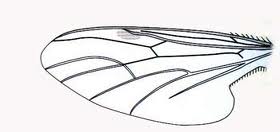Forewings. Attached to the thorax, these wings are tough and leathery and help protect the insect. They are not usually used for flying and are held out of the way during flight. The characteristic spots on ladybird beetles are located on these wings.
Head. An insect’s head is found at the front of the body. The head contains the brain and sense organs. Nerves extend throughout the body and can direct many activities independent of the brain. A headless cockroach, for example, can live for a week before it starves to death.
Legs. An insect’s three pairs of legs are attached to the thorax. Depending on the species of insect, the legs are used for walking, running and jumping – sometimes very successfully. A 12 mm (0.47 in) long click beetle can jump 300 mm (11.8 in); a cockroach can run 30 cm (11.8 in) a second. The sticky pads and claws on the ends of their feet enable flies to walk upside down on ceilings. Insect legs also have other functions. Crickets have sound organs akin to ears on their front knees; grasshoppers rub their legs their legs together to produce their song.
Abdomen. An insect’s abdomen lies behind the head and the thorax. No legs are attached to the abdomen. The abdomen contains the digestive and reproductive organs. Insects do not have lungs. Instead, they breathe through tiny openings in the abdomen called spiracles. In females, the abdomen contains the egg-laying organ, the ovipositor.
Eyes. Insects have two types of eyes – compound and simple. The two compound eyes detect swiftly moving objects. Each compound eyes may be made up as many as 30,000 separate lenses that produce a mosaic effect. The simple eyes are used for seeing nearby objects and changes in light intensity. Each simple eye has a single lens overlying a series of light-sensitive nerve elements.
Antennae. The antennae are located on the top of the insect’s head. The antennae are used to detect air movements, vibrations and smells. A dung beetle’s sense of smell is so highly developed that the beetle will begin to move towards buffalo dung even before it hits the ground.







